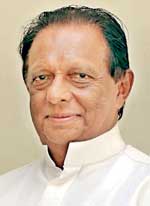Reply To:
Name - Reply Comment
 By Chandeepa Wettasinghe
By Chandeepa Wettasinghe
The government may start limiting hotel construction in Colombo, as concerns of oversupply are now rising, Tourism Development and Christian Religious Affairs Minister John Amaratunga said yesterday.
“Now, so many new hotels are coming up in the city. In fact, we’re now thinking that it’s time to say, ‘Enough in the city, please go out of the city’,” Amaratunga told Mirror Business yesterday after being felicitated at the Sri Lanka Tourism office for being appointed as a United Nations World Tourism Organisation General Assembly Vice President.
Limiting hotel construction seems to coincide with the Central Bank and Finance Ministry’s decision that credit limits may have to be imposed on construction and real estate if activities in these sectors continue to speed up beyond the absorption capacity and undermine the country’s financial system. Amaratunga noted that with the congestion in the city, it would not be possible to accommodate more hotels and tourists.
Colombo is being transformed into a mega city under the Western Province Megapolis Project and the government is now engaging in more in-depth urban planning, including better public transport services to fight congestion. However, the project will take decades to fully implement.
Due in part to the post-war prosperity and tourism boom and in part to the government boosting up the land prices in sales to foreign investors, most government and private land to be bought and developed in Colombo over the past five years have mainly been apartments, hotels and mixed-development projects.
The past few years have seen the entrance of many three to four-star hotels, while a handful of five-star hotels from international brands such as Movenpick, Shangri-La and Grand Hyatt are now coming online.
The occupancy rates in Colombo city hotels were over 75 percent from 2010 until 2016—during the double-digit tourist arrivals boom experienced on each of the seven years following the conclusion of the three-decade civil war in 2009.
However, the boom appears to have come to an end this year, with the first eight months of 2017 seeing an arrivals growth of just 3.5 percent year-on-year.
The Colombo city hotels, which also cater to the majority of business travellers, may also be getting less bookings from business travellers, who made up just 1.8 percent of arrivals to Sri Lanka in 2016 (36,915 tourists), compared to 12.7 percent of arrivals in 2010 (78,538 tourists).
The rise of the informal sector and supplementary establishments is helping to push accommodation in Colombo to an oversupply as well. The Colombo city hotels enjoy a minimum room rate, which deteriorates the functions of market forces.
A spokesperson from John Keells Holdings PLC, which is the largest leisure sector operator in Sri Lanka and in Colombo, said that although its brand Cinnamon has plans to operate a few more lean-mean three-star hotels similar to Cinnamon Red in Colombo, if the government feels that the city is becoming oversupplied, implementing construction restrictions would be natural.